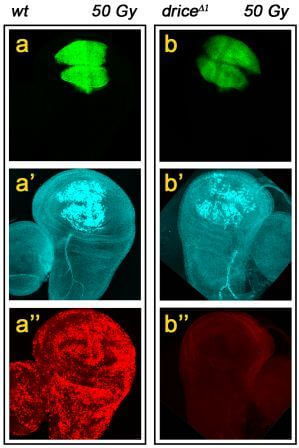Researchers at the Weizmann Institute examine how cells decide whether to die?

of apoptosis activated as a result of radioactive radiation - in a normal fly (left)
and a mutant fly lacking Drice (right). Top row: the "reported" protein expression area
Painted with green fluorescent paint. Middle row: fluorescence labeling of a cut
The protein "reported" by the caspases after the activation of apoptosis. news
Bottom: fluorescent labeling of dead cells. In the normal fly many cells die
After exposure to radioactive radiation, but in a fly without Drice, there is almost no apoptosis
To die or not to die? This question is asked from time to time by every living cell. The answer given to the question may have decisive consequences for our health. For example, when cancer cells refuse to die, and show resistance to drugs, they can cause the patient to die. On the other hand, Parkinson's disease and other neurodegenerative diseases occur when certain nerve cells in the brain die too quickly. Therefore, a thorough understanding of the main genetic program that executes cell death, called apoptosis, is essential for the development of drugs for many diseases.
A study conducted at the Weizmann Institute of Science, and which was recently published in the scientific journal Journal of Cell Biology, reveals new and extremely important information about the apoptosis program. Dr. Eli Arma and research student Anat Florentin, from the department of molecular genetics at the institute, revealed in detail how the final stage in the cell death program works, and discovered a mechanism that determines the cells' tendency to undergo apoptosis.
Apoptosis is triggered by a variety of signals, but the last step, the "weapon" that kills the cell, is always the same: it mainly includes destructive enzymes, called caspases, which kill the cell in a controlled manner by cutting hundreds of proteins inside it. Scientists knew that two caspase enzymes, caspase-3 and caspase-7, are active in mammalian cells, which participate in apoptosis, but they did not know why two similar enzymes are needed for the process. Dr. Arma and Anat Florentin carried out the research in fruit flies, in which similar enzymes, called Drice and Dcp-1, work. Their findings allow conclusions to be drawn also regarding the two caspases enzymes in mammals.
The findings show that Drice is the main killing machine: this enzyme is able to destroy the cell even when acting alone, although its work is more efficient in the presence of Dcp-1. Dcp-1's main function, however, is to determine the killing rate, meaning how many cells will die and how quickly. Dcp-1 can also kill cells on its own, but it is only able to do so if it is present in the cell in large amounts.
One of the main findings of the study is that the two caspases can kill the cell only when their activity rises above a certain threshold. Below this threshold, the cell survives, because it is sufficient to renew the proteins that the caspases destroy. This discovery explains, among other things, how certain cells manage to use the destructive weapon of caspases for various important processes in the cell, such as the development of sperm cells and the formation of the eye lens and red blood cells, without risking self-killing: in these cases, the cells use low amounts of caspases, or use them for a long time A short period of time, so no apoptotic death was caused.
Why are two enzymes needed to perform one action? The scientists believe that both types of weapons provide more precise control than one enzyme. The Drice enzyme is more like a mace, which is suitable for wholesale destruction. On the other hand, the Dcp-1 enzyme is more like a chisel, with which the cells can be gently broken up.
The study shows that the tendency to apoptosis, which varies greatly from one cell type to another, is also determined by the amount of caspases in the cell. Thus, cells with a low propensity for apoptosis include fewer caspases. Such are the nerve cells in the brain, whose number is limited, or the sperm cells and the eye cells, which could die in any contact with the external environment if they were not so resistant to apoptosis. Conversely, in cells with a high tendency to apoptosis, a high level of caspases is found. These are cells that the body is ready - or should - give up relatively easily, because they regenerate; For example, the hair cells or cells in the inner walls of the intestines, which need to be constantly regenerated following the damage caused by the digestive acids.
The scientists were able to discover these details about the caspases by investigating their activity in whole animals - genetically modified fruit flies - and not in cell culture. The scientists inserted a "reporter" gene into the flies' genome, which marked with a fluorescent color the transgenic protein that was destroyed during apoptosis. With the help of the "reporting" of the dye, the scientists were able to locate and quantify the activity of the various caspases in the fly's body, through observation under a microscope.
The new research by Weizmann Institute scientists may also have important implications for the development of anti-cancer drugs. The research shows that the activity of caspases is more complex than previously believed, therefore, in order to develop drugs that increase apoptosis, it is necessary to make sure that the drugs increase the activity of caspases above the threshold that ensures effective killing of cancer cells.

3 תגובות
I liked !
It's like there are left and right parties, each destroying the country in their own style.